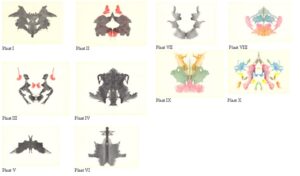
The Rorschach test is a psychological test used by psychologists to examine a person’s personality characteristics and emotional functioning. It is especially useful in cases where patients are unwilling to openly describe their thinking processes (1). Tester and subject usually sit next to one another at a table, where the subject is presented with ten inkblots, each printed on a separate card. The subject is asked to respond to all of the inkblots and then is presented with the cards again in a set sequence. The subject is asked to describe what makes a certain inkblot look the way it does. For example, if one subject reports seeing a butterfly in one of the inkblots, he or she is asked to describe why that is the case. The subject is then asked to hold the cards and may rotate them. Interestingly, factors such as whether or not the cards are rotated, and whether or not permission is asked to rotate them in the first place, is of diagnostic value and may contribute to the assessment (2). The goal of the Rorschach test is to provide data about the cognitive style and personality of the subject, with the assumption that an individual will class stimuli based on his or her personal needs, base motives, and conflicts, representative of the process by which he or she deals with stimuli in real-world situations.
Sources:
1. Gacono, Carl B., and J. Reid Meloy (1994). “The Rorschach Assessment of Aggressive and Psychopathic Personalities (Personality and Clinical Psychology)“. Hillsdale, N.J.: Erlbaum.
2. Weiner, Irving B., Donald K. Freedheim, John A. Schinka, and Wayne F. Velicer (2003). “Handbook of Psychology, Assessment Psychology (Volume 10)“. New York: Wiley.